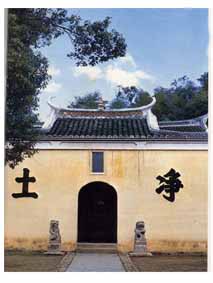| About Us | Site Map | Contact Us |
|
|
| Home | Schools & Teachings | Dharma Centers | Buddha & Bodhisattva Directory | Cosmos |
|
|
The Chinese Buddhist Schools and Teaching
Pure land school
|
For the pure land believers, these paradises are geographically localizable places of bliss; however, fundamentally they stand for aspects of the awakened state of mind, and the directions (east, west, etc.) have iconographical meanings. However pure land generally guarantees no evil would exist, the people would be long-lived and would receive whatever they desired, and from where they might attain Nirvana, which is to be realized in the ensuring rebirth. In addition, in a pure land, retrogression is no longer possible. But in the pure land Buddhism, the attainment of Nirvana is not the goal; it is rather to become reborn in the pure lands. Among these many pure lands, the most important one is Sukhavati, the pure land of the west or the western paradise, ruled by Buddha Amitabha. According to the Amitabha sutras, this pure land is full of lotus and the Amitabha Buddha uses lotus as vehicle to receive his adherents to this bliss world, thus this school is often called "the Lotus school". |
|
The goal of the adherents of this school is to be reborn in the pure land of Buddha Amitabha. As described in the sutra, Buddha Amitabha has made a vow to cause all beings to be reborn in his pure land Sukhavati. Only a successful practice, which includes recitation and visualization as the external condition and total faithful devotion toward Amitabha as the inner condition, can guarantee the rebirth in this paradise. Since its adherents rely upon the external help of Amitabha, the way of the Pure-land school is often regarded as the "faith path" or the "easy path". The tradition of Pure-land practice can be traced back to the monk Hui-yuan. In 402 A.D. Hui-yuan founded a 30 people group where monks and layman assembled in a temple (Fig. 1) and vowed to be reborn in the pure land before an image of the Buddha Amitabha. Hui-yuan is thus regarded as the first patriarch of this school. The second patriarch Tan-luan (476-542) contributed considerably to the development of the Pure-land school. He advocated the attainment of liberation in one life cycle is impossible without faith in the infinite power and compassion of Buddha Amitabha. He rejected the "hard path" of the other schools which required many life cycles of practice to accumulate merit and fostered the "easy path", in which it is sufficient to recite Amitabha's name with complete devotion to be reborn in the pure land. He further declared that even evil men were eligible for the pure land if they sincerely uttered "Namo Amida Buddha" (take refuge in the Buddha Amitabha). It is believed that his following was largely among the laity, as there does not seem to have been any important monk followers of his own who established this tradition as an independent lineage. Shan-tao (613-681) is considered the actual founder of the organized Pure-land school. He was the most prolific and successful patriarch of the school. He composed important commentaries on the Amitayurdhyana-sutra. In his time the school experienced a major upsurge, since its practice, compared with that of other schools, seemed relatively easy. PS: An eastern paradise is the pure land of Bhaishajua-guru Buddha (Medicine Guru Buddha). The Abhirati paradise of Buddha Akshobhya is also in the east. In the south is the paradise of buddha Ratnaketu, in the north that of Buddha Dundubhishvara. A new pure land will be created by the future buddha Maitreya, who presently still dwells in the Tushita Heaven. They are the hope of believers who wish to be reborn in them. The decisive factor is not their good karma but rather the aid of a given buddha, who has taken the vow to help all those to rebirth in his pure land turn to him in faith. |
| About Us | Free Books | Site Map | Contact Us | ||
| Copyright © 1999-2020 Manjushri. All Rights Reserved. | ||

 The Pure land tradition is one of the oldest and most influential in Chinese Buddhism. In Mahayana there are countless buddhas and pure lands in the universe. Each pure land (also called buddharealm) is ruled over by a buddha.
The Pure land tradition is one of the oldest and most influential in Chinese Buddhism. In Mahayana there are countless buddhas and pure lands in the universe. Each pure land (also called buddharealm) is ruled over by a buddha.